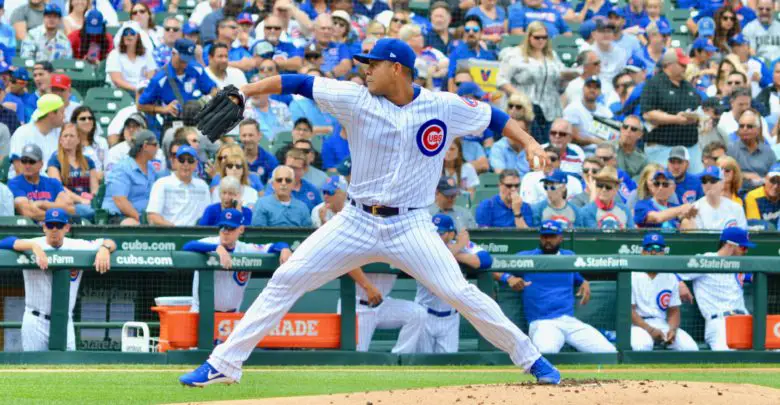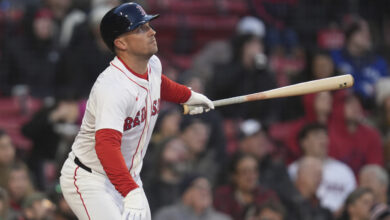
Alec Mills Continues to Pitch Well, Potentially Forcing Cubs into Big Decision on José Quintana
It doesn’t matter if the move resulted in a much better situation for a particular player, there’s always a little extra incentive to beat the team that traded you away. That was the case for Alec Mills, who got the chance Monday evening to face the Royals for the first time since he was sent to the Cubs in exchange for outfielder Donnie Dewees just prior to the 2017 season.
Mills was chosen by the Royals in the 22nd round out of UT Martin in 2012 and came up through their system as a starter before making his debut with three relief appearances in 2016. It wasn’t until 2018 that he got another cup of coffee, pitching 18 innings for the Cubs over seven games, two of which were starts. He doubled those innings and starts last season, appearing in nine total MLB games, and started to build a case for himself as a legit option.
With an open competition for the fifth rotation spot and confidence from excellent results over limited big-league action, Mills headed to Mesa filled ready to prove himself. David Ross praised the soft-tossing righty’s “low heartbeat,” likening him to Kyle Hendricks during spring training, but Tyler Chatwood was the odds-on favorite to start prior to the shutdown.
That remained the case upon MLB’s resumption, until José Quintana sliced his thumb on a broken wine glass and required surgery to repair a damaged nerve. Mills has made the most of his new opportunity, going 2-0 with a 1.38 ERA and making just one real mistake — a homer allowed to former teammate Nick Castellanos — over 13 innings. That includes seven shutout innings against his old team in what was easily his best MLB performance to date.
After missing his spots early, the righty settled in and started locating both his slider and sinker — a pitch he’d been tinkering with this spring — for increased efficiency. The slider was particularly effective, leading Mills to throw it a career-high 21 times after going to it just five times in his first start. He also threw a career-high 31 sinkers, generating three of his four strikeouts in the process.
Though he’s far too stoic to have let it show out on the mound, Mills very much wanted to prove a point.
“That was a team that got rid of me a couple years ago. I understand the business, and my job is to make it hurt whenever I face them again,” Mills said. “It took four years for it to happen, but I’m glad it did.”
More than just a singular performance, this start added to the incredible run for the Cubs rotation as a whole through two turns. According to Stats By STATS, the .156 batting average to which starters have held their opponents so far is the lowest allowed by any team’s starters through 10 games of a season since 1920. While that dominance can’t be expected to continue at the same pace moving forward, Mills’ contributions may make it difficult for the Cubs to figure out what to do with Quintana.
“In my heart, I always felt like I belonged,” Alec Mills said after his first start. “It was just a matter of them giving me the job. Me earning it and them giving it to me. Obviously what happened with Q is unfortunate, but I just want to take this and run with it and make them make the tough decision.”
Quintana threw a 38-pitch bullpen session Saturday that pitching coach Tommy Hottovy said “looked good,” then threw 30 pitches Monday to simulate his normal between-starts routine. Provided he has no setbacks, the plan is for the lefty to throw a two-inning simulated game at the Cubs’ alternate site in South Bend on Thursday. If we assume at least one more bullpen and another sim game before he gets clearance to play, the Cubs have about a week to figure everything out.
The way things are going now, it would be foolish and borderline unconscionable to insert Quintana right back into the rotation once he’s activated. Not only is the current group performing at a very high level, but you’re talking about a guy who hasn’t pitched competitively since early March and hasn’t pitched in a meaningful game since last September. Not to mention he’ll be stretched out to maybe four innings at the most.
While it’s not reasonable to assume the starters maintain this pace, three of the spots are set in stone barring injury. That leaves just Mills and Tyler Chatwood, who’ve arguably been the Cubs’ best and most consistent pitchers through two turns. And since Mills was ostensibly the odd man out when spring training ended, his is probably the most precarious spot. But, again, he’s thrown 13 innings in two starts and shouldn’t be displaced by a pitcher who almost certainly can’t replicate that same length.
The best role for Quintana, at least initially, would seem to be as a piggyback starter or long man. The roster is going to contract here soon and the bullpen isn’t the most bulletproof aspect of the team, so having a way to essentially guarantee a minimum of seven innings before turning the ball over to the “real” relievers would make David Ross’s job easier. Or perhaps Q works as an opener, pitching two or three innings before giving way to the bulk starter.
Whatever the case, the Cubs would be wise to showcase him in situations that lend themselves to his personal success as well as that of the team. In addition to winning ballgames, such a strategy might also help them with their current financial predicament. Even if you believe, rightly so, that ownership can well afford to exceed the competitive balance tax, it should be very clear to you that they do not wish to do so. That means trying to get under the competitive balance tax threshold they’re currently projected to exceed for the second straight season.
Looking up and down the roster, Quintana is far and away the most convenient and logical trade chip the Cubs have right now. Not only is his salary big enough to get them under the CBT, but he’s probably their most expendable pitcher who also has value. They’re 8-2 without him and can reasonably expect the bullpen to come together, either from improved performances like the ones we’ve seen of late or through further reinforcements from the alternate squad.
There should be a market for Quintana’s services as well, particularly considering recent developments for the Braves or even his former employers on the South Side. Atlanta just lost Mike Soroka to a torn right Achilles and is projected to be more than $23 million under the CBT as things stand right now. The White Sox are in even more dire straights with Michael Kopech opting out, Reynaldo Lopez on the IL, and Carlos Rodon exiting Monday’s game with shoulder issues after struggling to get his fastball up to 90 mph.
With nearly $30 million in available space under the threshold, the Sox can easily afford to add Quintana should they feel the need. And why wouldn’t they, particularly when a deal would probably include the Cubs eating some money — enough to keep them from being over the CBT — in exchange for a player to be named later in what amounts to a salary dump? Quintana doesn’t have to move and his re-acclimation to a new/old organization would be minimal.
All things considered, that seems like the dream scenario for the Cubs and I’d be shocked if Theo Epstein hasn’t been eyeing some iteration of it. The Cubs get salary relief and don’t have to jack with the rotation, the Sox get a starter they appear to desperately need at a relatively low cost with no commitment beyond this season, and Quintana doesn’t have to uproot his life.
The payroll part of all this is what really drives it home for me, since I can’t — or maybe “don’t want to” is better — envision a situation in which the Cubs have a third consecutive stagnant winter that sees them banking all their expiring contracts. It seemed inevitable that they’d have made a move or two this spring to get under, but the shutdown but the kibosh on any such plans. Then Quintana cut his thumb and both Chatwood and Mills have been shoving.
Pretty much any other deal the Cubs could make to shed salary would make them appreciably worse from a competitive standpoint this season and maybe even beyond. Of course, they are much more aware of both their roster and its financial implications than I am, not to mention what future baseball payroll budgets will look like. I won’t revisit how the truncated season almost certainly tanked Marquee’s revenue projections and thus eliminated even the slim potential for payroll growth, but perhaps you’d like to put in a pin in that one for future conversations.
I brought up these same possibilities with much less nuance late Monday night and was met with a bit of resistance from some fans. Mostly agreement, just not all. What say you, Dear Reader, is Quintana a traded man walking or do the Cubs need him on the staff? If yes to the latter, in what role should he serve? See you in the comments.

